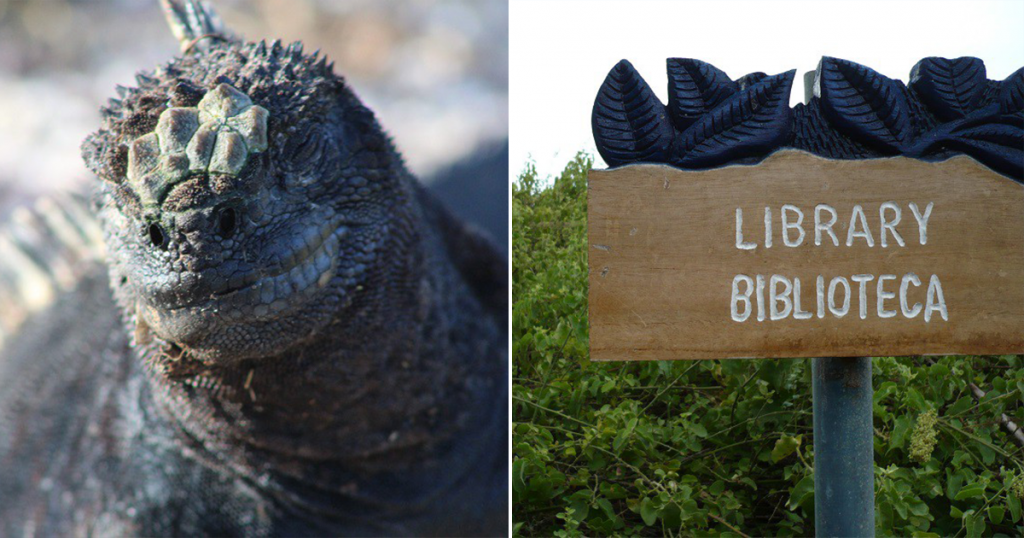Librarians work all over the world, from big cities and suburbs to the furthest reaches of the planet. Case in point: Edgardo Civallero is a librarian stationed in the Galápagos, an archipelago off the coast of Ecuador known for influencing Charles Darwin’s theory of evolution.
Civallero is part of the Charles Darwin Foundation (CDF), a scientific organization dedicated to preserving the islands’ biodiversity. The foundation’s research station features a library and archive that Civallero is tasked with coordinating. He recently spoke with I Love Libraries about the joys, challenges, and surprises of working in such a unique library setting.
What does your job with the Charles Darwin Foundation entail?
The Charles Darwin Research Station is where an international team of scientists and conservationists work, researching the unique species that populate the island—like the giant tortoise, the marine iguana, or the flightless cormorant. Therefore, the library I coordinate is aimed at providing them all the material they need, which turns the library into a specialized one. However, being the biggest, oldest, and practically the only library in Galápagos, it also serves the local community.
I also coordinate the archive, where the entire social and scientific memory of CDF (and a part of Galápagos’ history) is preserved. And right now, I’m creating a new space: a museum, in order to display and take care of a handful of archaeological and historical pieces related to Galápagos’ past.
Even if I am the only professional librarian in the islands, I am the head of a small, amazing team of staff who are learning the profession by putting it into practice.
Galápagos is a very special place in many ways. Besides being a sort of paradise in the middle of the eastern Pacific Ocean and a living laboratory for evolution, it is also a very isolated place, despite being a tourist destination with heavy visits all year long. Internet service is weak, there are no cultural activities or bookshops, and movements are strongly limited to a very small land surface. Since the Galápagos are a National Park, a Biosphere Reserve, and a UNESCO World Heritage Site, the islands are quite protected, and a lot of “normal” activities are not allowed there.
Isolation makes life a bit hard for the permanent population of the islands. Food and most other supplies arrive from the continent by boat, which means that sometimes there are shortages in the archipelago and prices are really high. Water supply is also a problem, creating a number of health issues. Massive tourism is another topic that should be discussed, but nobody seems to be willing to tackle it. As with many other things in our world, every light has its shadow, and Galápagos is no exception.
How did you come to work in such a unique setting?
I applied to an international call for librarians to fill the position. Since I studied oceanography and biology before becoming a librarian, and I speak several languages fluently, I considered I had a chance. And I did: I was selected among 60 candidates from all over the world. Of course, I had to move to Galápagos and start a new life in the islands—which was probably the biggest challenge of all.
What do you like most about your job?
The environment, of course. I work yards away from the sea, and the marine iguanas usually walk in front of the library’s door. I can hear the waves (and the Darwin’s finches) from my desk. Of course, half of the year we have what we call garua weather: cloudy, cold, and with a never-ending drizzle wetting everything. But that’s also lovely, at least for me.
Also, I love being in charge of the biggest and oldest library in my territory. That is absolutely challenging, especially considering that I don’t have a lot of resources and I have to use all my knowledge to improvise solutions. Taking care of the archive and the future museum is wonderful, too, because I have in my hands the social and scientific memory of this place.
Is there anything that has surprised you about working as a librarian in the Galápagos?
Almost everything I found here since I arrived surprised me. I came to Galápagos with no expectations, and I found so many things along the way that amazed me. But to choose one thing, I’d go for the tameness of local fauna. I had read about it before travelling, but witnessing it here, in the field, is absolutely surprising. Giant tortoises, sea lions, finches, iguanas, lizards, sea birds, and even the butterflies seem not to fear the human presence: they live their lives just two yards away from my eyes. That closeness to the local natural world is something that I hadn’t experienced anywhere else.
Is there anything else you’d like to share?
I invite all my colleagues in the library profession to consider supporting the work I do here. Right now I’m developing an outreach project to bring libraries to all the inhabited islands by means of a mobile library service. One island, Floreana, has never had a library (our mobile library is the first one to arrive there), and others haven’t had a library for at least a decade.
Also, I’m trying to expand the collection of the library in order to provide better services to the local community, since the current collection is mainly focused on science and scientific endeavors. Finally, we’re putting a lot of effort into preservation and conservation tasks. Local weather and the proximity of sea is our number one enemy in a building that was never intended to be a library or archive. Dealing with humidity and sunlight is an absolute nightmare, and a lot of material is needed. Those interested in supporting the CDF’s Library & Archive can contact me for further information.
Subscribe to the I Love Libraries newsletter for more amazing stories about libraries and librarians. Photos courtesy of Edgardo Civallero.



